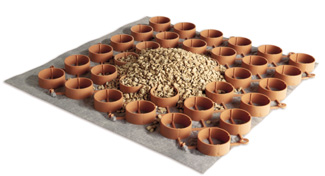

Care of meadows depends on the tastes and sensibilities of the owner(s). We recommend weed whacking meadow areas two to three times per year. If a spring green color is desired, meadow grass will grow faster with increased water, however, this will also require more maintenance. I personally prefer the look of a natural meadow that uses less water, less work and has abundant pollinators and birds. Young children will have a field day rolling in the long grasses while adults can rest assured knowing there are no pesticides to worry about!
In constructing this garden, we chose solutions employing sustainable techniques and technologies. In many instances, these technologies are low-tech not high-tech. With each project we seek to understand and replicate the natural systems that are presently, or were, inherent at the site before development. Impervious surface areas can alter the water cycle and destroy the aquatic eco-systems. They also change the shape of stream channels, raising water temperatures and washing pollutants into aquatic environments. It’s important to recognize this and reduce or eliminate the use of impervious hardscapes. Use of pervious hardscaping allows rainfall to percolate directly into site soils, producing healthy, vigorous and abundant life while creating naturally beautiful gardens that mimic the exquisite natural landscapes of our planet.
The less we disturb the dirt, the more sustainable the garden will be. A natural garden is the one that thrives with very little help from humans. In planting, we replicate the plant communities that naturally occur in the area.
